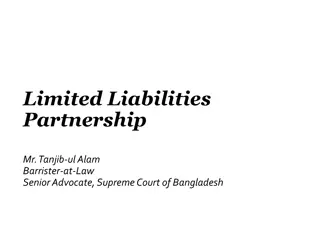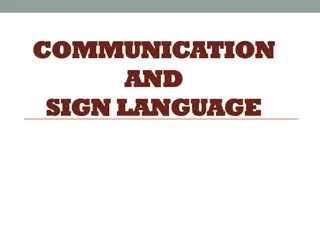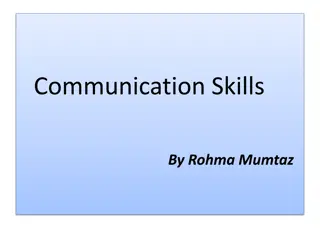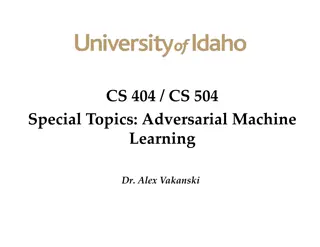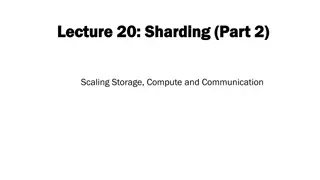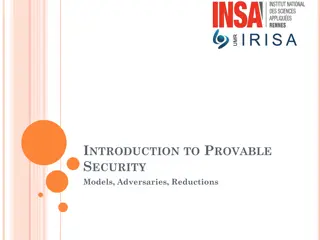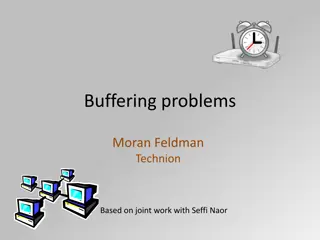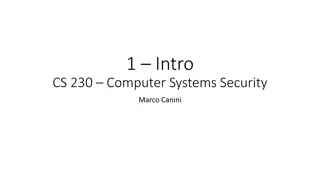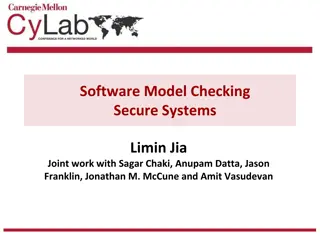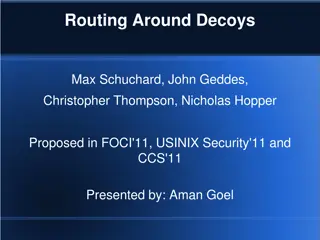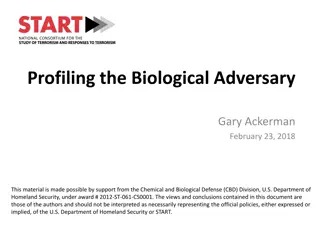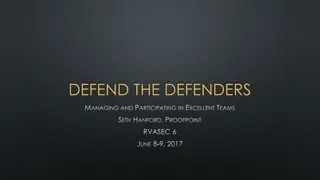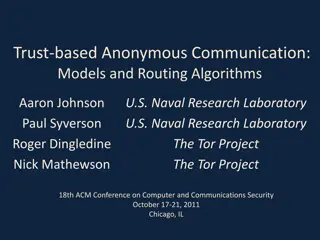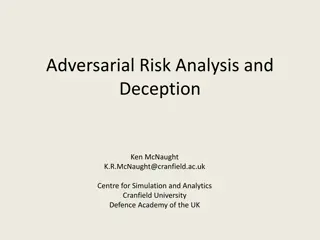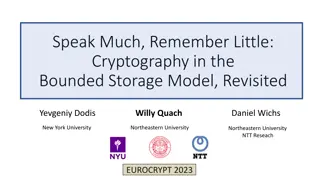Reliable Communication in the Presence of Limited Adversaries Study
This study by Sidharth Jaggi from The Chinese University of Hong Kong delves into reliable communication in scenarios with limited adversaries. The research group focuses on designing and optimizing codes, algorithms, and networks for information theory, exploring various background communication scenarios and related work. Benchmark channel models and different types of adversaries are discussed, along with computations and efficient code constructions.
Download Presentation

Please find below an Image/Link to download the presentation.
The content on the website is provided AS IS for your information and personal use only. It may not be sold, licensed, or shared on other websites without obtaining consent from the author.If you encounter any issues during the download, it is possible that the publisher has removed the file from their server.
You are allowed to download the files provided on this website for personal or commercial use, subject to the condition that they are used lawfully. All files are the property of their respective owners.
The content on the website is provided AS IS for your information and personal use only. It may not be sold, licensed, or shared on other websites without obtaining consent from the author.
E N D
Presentation Transcript
1 RELIABLE COMMUNICATION IN THE PRESENCE OF LIMITED ADVERSARIES Sidharth Jaggi, The Chinese University of Hong Kong
3 Research group: Codes, Algorithms, Networks: Design & Optimization for Information Theory Information Theory Codes, Algorithms, Networks: Design & Optimization for ME Qiaosheng Zhang Mayank Bakshi Sidharth Jaggi Zitan Chen Michael Langberg SwanandKadhe Alex Sprintson Anand Dilip Sarwate Bikash Kumar Dey
4 Background Communication Scenario Bad guy Calvin Alice Bob 011100110110111101110011 ?? ?? ?? ?? (Adversarial) Noisy Channel Encoder Decoder Received word Message Codeword Decoded message
5 Background Related Work Benchmark channel models One extreme: random noise (Shannon) = ukw.h.p. ?? ?? ?? ?? ?? Alphabet ? (q-ary symmetric channel) ? =? ?? errors ? 1 general q 1 q=2 (binary) 1 large q [Sha48] {Sha48] [Sha48] R R R 0.5 1-1/q 1 p p p Many good codes (computationally efficient, close to capacity)
6 Background Related Work Benchmark channel models The other extreme: omniscient adversary (Hamming) One extreme: random noise (Shannon) ?? ?? ?? ?? Calvin He knows everything ! 1 q=2 (binary) 1 large q 1-2p [Reed- Solomon]/[Singleton] [McERRW77] R R [Gilbert Varshamov] 0.25 0.5 1 0.5 p p Good, computationally efficient codes for large q, not so much for small q
x2(0), p2 x1(0), p1 x3(0), p3 x5(0), p5 x4(0), p4 Avg Pe: Max Pe: 1 R 0.5 p
Avg Pe: Avg Pe: Max Pe: Max Pe: 1 1 [McERRW77] R R [Gilbert Varshamov] 0.5 0.5 p p
11 Background Related Work Benchmark channel models One intermediate model: oblivious adversary ?? ?? ?? ?? s ?? Alphabet ? en: Error function of codebook, message uk, but NOT codeword xn ? =? ?? errors s: Secret key known only to Alice (NOT Bob/Calvin) ? 1 q=2 (binary) 1 large q (AVC capacity) (AVC capacity/folklore) R R 0.5 1 p p Good, computationally efficient codes recently constructed for q=2 [Guruswami-Smith-10]
12 Background Related Work Benchmark channel models Another intermediate model: common-randomness between Alice/Bob ?? ?? ?? ?? s s ?? , Alphabet ? en: Error function of codebook, codeword xn, but NOT uk k: decoded codeword function of s ? =? ?? errors s: Secret key known to Alice and Bob (NOT Calvin) ? 1 q=2 (binary) 1 large q (AVC capacity) (AVC capacity/folklore) R R 0.5 1 p p Good, computationally efficient codes (Eg: Ahlswede s permutation trick.)
14 Background Related Work Weaker channel models List-decoding - weakened reconstruction goal ?? ?? ?? 1 q=2 (binary) 1 large q [Elias,Wozencfraft] [Elias,Wozencfraft] R R 0.5 1 p p Good, computationally efficient codes recently constructed for large q [Guruswami-Rudra06], q=2 open
15 Background Related Work Weaker channel models List-decoding - weakened reconstruction goal Computationally bounded adversaries - weakened adversary power ?? ?? ?? ?? Calvin Computationally efficient encoding/decoding schemes 1 q=2 (binary list- decoding) 1 large q Micali-Sudan (modified with Guruswami-Rudra) Smith-Guruswami R R 0.5 1 p p
18 Causal adversaries Between oblivious and omniscient adversaries Current Future 1 2 3 4 5 6 7 8 9 10 11 12 13 14 Transmitted Word 0 1 1 1 0 ? ? ? ? ? ? ? ? ? Tampered Word 0 1 0 1 * Calvin Calvin Calvin Calvin Calvin
19 Causal adversaries Between oblivious and omniscient adversaries Causal large alphabet Delayed adversary Delayed large q (overwrite) 1 1 1 Causal large q Delayed large q (additive) 1 Delayed q=2 d R R R R 0.5 0.5 1 1 0.5 p p p p Sha-mming
20 Causal adversaries Capacity (Chen, J, Langberg, STOC 2015) Sha-mming
21 Causal adversaries Between oblivious and omniscient adversaries Analysis of all possible causal adversarial behaviours 1 One possible adversarial trajectory (Slopes are bounded) ?? ? ? ?
22 Causal adversaries Analysis of all possible causal adversarial behaviours Proof techniques overview - Converse: Babble-and-push attack 1 2 3 4 5 6 7 8 9 10 11 12 13 14 Transmitted Word 0 1 1 1 0 ? ? ? ? ? ? ? ? ? Tampered Word 0 1 0 1 1 Babbling phase Pushing phase Randomly tamper with ? ? bits
23 Causal adversaries Proof techniques overview - Converse: Babble-and-push attack Pushing phase 6 7 8 9 10 11 12 13 14 1. Construct a set of codewords based on corrupted bits transmitted so far 2. Select one codeword from the set and then push the transmitted codeword towards the selected one Transmitted Word 0 0 1 0 1 1 0 1 1 Tampered Word 0 1 1 0 1 0 0 1 1 Selected Word 0 1 0 1 1 0 0 1 1 Pushing phase
24 Causal adversaries Proof techniques overview - Converse: Babble-and-push attack Pushing phase 6 7 8 9 10 11 12 13 14 1. Construct a set of codewords based on corrupted bits transmitted so far 2. Select one codeword from the set and then push the transmitted codeword towards the selected one Transmitted Word 0 0 1 0 1 1 0 1 1 Tampered Word 0 1 1 0 1 0 0 1 1 Selected Word 0 1 0 1 1 0 0 1 1 Pushing phase The tampered word lies in midway between the transmitted word and selected word.
25 Causal adversaries Proof techniques overview - Converse: Babble-and-push attack Plotkin bound: Binary code with dmin> n(1+ )/2 has O(1/ ) codewords 1? Group of size
26 Causal adversaries Proof techniques overview - Converse: Babble-and-push attack Babbling phase Pushing phase 1 2 3 4 5 6 7 8 9 10 11 12 13 14 Transmitted Word 0 1 1 1 0 ? ? ? ? ? ? ? ? ? Tampered Word 0 1 0 1 1 ? ? ? List-decoding condition Energy-bounding condition Shannon-capacity of first l channel uses # message bits remaining bit-flip budget Avg pairwise distance (Plotkin)
29 Causal adversaries Proof techniques overview - Converse: Babble-and-push attack Proof techniques overview Achievability 1 Possible decoding points ?? Trajectory of the babble-and-push strategy ? ? ?
3 0 Causal adversaries Proof techniques overview - Converse: Babble-and-push attack Proof techniques overview Achievability Encoder: concatenated stochastic codes ? ?1 ?1(?,?1) code ?1 ?? bits ?? bits ?? bits
31 Causal adversaries Proof techniques overview Achievability Encoder: concatenated stochastic codes ? ?1 ?1(?,?1) code ?1 ? 1 ?(?,? 1 ?) ?1(?,?1) ?2(?,?2) ?? bits ? bits ?? bits ?? bits
32 Causal adversaries Proof techniques overview Achievability Encoder: concatenated stochastic codes Decoding process: list-decoding + unique decoding ? 1 ?(?,? 1 ?) ?1(?,?1) ?1(?,?1) ?2(?,?2) ?2(?,?2) ??(?,??) ??(?,??) ??? bits Unique decoding phase List-decoding phase Obtain a list of messages
3 3 Causal adversaries Proof techniques overview Achievability Encoder: concatenated stochastic codes Decoding process: list-decoding + unique decoding If two words differ in a limited number of positions, they are said to be consistent. ? 1 ?(?,? 1 ?) ?1(?,?1) ?2(?,?2) ??(?,??) ??? bits Unique decoding phase List-decoding phase Consistency Checking Encodings Obtain a list of messages
34 Causal adversaries Proof techniques overview Achievability Encoder: concatenated stochastic codes Decoding process: list-decoding + unique decoding List of right mega sub-codewords Received right mega sub-codeword Fails consistency checking
35 Causal adversaries Proof techniques overview Achievability Encoder: concatenated stochastic codes Decoding process: list-decoding + unique decoding With high probability, Bob succeeds in decoding Received right mega sub-codeword Passes consistency checking!
3 6 Summary (Chen, J, Langberg STOC 2015) Binary Bit-flips Binary Erasures
37 Sneak Previews (Chen, Jaggi, Langberg, ISIT2016) q-ary online p*-erasure p-error channels (Dey, Jaggi, Langberg, Sarwate ISIT2016) one-bit delay p*-erasure channels Stochastic encoding Deterministic encoding
41 Other related models Limited-view adversaries: Multipath networks with large-alphabet symbols Adversary can see a certain fraction and jam another fraction ITW 2015, ISIT 2015 Myopic adversaries: Adversary has (non-causal) view of a noisy version of Alice's transmission ISIT 2015


